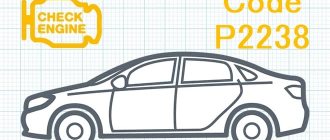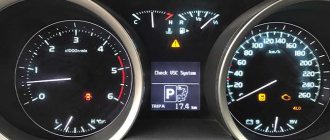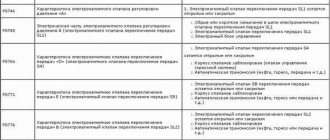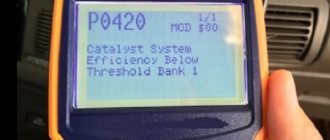Technical description and explanation of error P0401
This diagnostic trouble code (DTC) is a generic powertrain code. The P0401 code is considered a common code because it applies to all makes and models of vehicles. Although the specific repair steps may vary slightly depending on the model.
EGR is responsible for exhaust gas recirculation. It is part of the vehicle's exhaust emission system. Used to reduce combustion temperature, combustion pressure, and control nitrogen oxides.
Typically, the exhaust gas recirculation system consists of three parts:
- EGR valve.
- Actuator solenoid.
- Exhaust gas recirculation differential pressure sensor (DPFE).
They work together to provide the correct amount of recirculation depending on engine temperature, load, etc.
Code P0401 means that the OBD has detected insufficient exhaust gas flow in the intake manifold. When the engine exhaust gas recirculation valve opens.
1FZ-FE, EGR, P0401 and my 30 kopecks...
Initial data - LX450, intermittent code P0401 (Insufficient air flow through EGR valve) ...
Here's my path:
1) Check for the presence of vacuum in the tubes going to the modulator.
[attachmentid=37114]
2) Remove the modulator, open the top cover, clean the filter, check that no air is sucked in through the lower tube (the one that goes to the control valve) (i.e., the membrane is intact). If possible (disassembly is nearby), we replace the modulator with a green sticker with a modulator with a blue one (TLC60 and late eighties). Otherwise, we wash all the fittings and blow them out. We put the filter with the lid back.
3) For good measure, we remove the control valve (well, if you want to inspect the entire system - especially since the cunning Japanese have provided twist-out valve pins that make the task easier), spill it with VED-like liquid, check that when vacuum is applied to the upper tube, the inside of the valve moves needle, and that in doing so it opens a passage from the threaded part to the mating plane. We also check that if there is no vacuum, this passage is closed.
3-1) Put the valve in place, connect all the tubes except the one that comes from the intake manifold on the right (if you look at the car’s face). We start the engine, at idle we apply a vacuum to the control valve through this tube. Ideally, the engine should stall, but at worst it should wobble a lot.
That's it - the executive part is working for us. Now all that remains is the vacuum control valve, located in the depths of the intake manifold. In the Legion-Avtodata book about this valve, an outright imperialist lie is written (or a deliberate distortion of facts by our government) - they write there that if there is no voltage at the valve terminals, it should let air through, and if there is, it should close. In fact, it works exactly the opposite. To check and replace, at best you need to remove the throttle valve, and at worst, the upper part of the intake manifold.
In order to verify that the valve is faulty, it is enough to disconnect the tube going from the intake manifold to the EGR control valve (the one through which we choked the engine), and connect it to the vacuum tube going to the absorber (there is no vacuum on it at idle) through tee, or you can temporarily turn off the vacuum from the absorber. Next, we reset the fault code and drive. If the code does not appear within a few days, then the vacuum valve under the intake manifold is definitely to blame. If P0401 appears again, it means that steps have not been carried out carefully. 1-3.
What do we do with the valve if it is still faulty...
One imported bright mind suggested that when replacing a valve, remove the vacuum lines and install a new valve outside the intake manifold. Let's modify the idea.
1) We buy a carburetor vacuum valve from a VAZ, a tee and a vacuum tube from the same VAZ, two terminals for the valve.
2) Place the valve in the area of the top bolt of the power amplifier reservoir. We plug one of the valve holes.
[attachmentid=37120]
We connect the valve fitting, located at an angle (it is important not to mix it up, because otherwise the valve will let a little vacuum through when closed) with the EGR control valve (the same tube that we used to choke the engine), and apply vacuum to the second fitting. You can take it through a tee from the same absorber (before the absorber). In my case it was simpler - I took it from the vacuum fitting for HBO.
3) Where we connect - there is a connector next to the throttle position sensor, we find a blue-white wire (-12V valve control), cut off the wire from the connector, and to the half that goes into the harness we connect one of the VAZ valve terminals, We connect the second terminal to any of the yellow-red wires on the same connector without cutting it (+12V when the ignition is turned on).
[attachmentid=37121]
Everything has been collected. Let's check. We remove from the VAZ valve the terminal that is connected to the blue-white wire. We start the engine. At XX we connect the terminal (on the valve!) from which we removed the wire with the ground of the car - the valve should click, and the engine should stall, or it will wobble very much. Reconnect the terminal. All…
We reset the brain by removing the Gauge 15A fuse from the engine compartment fuse box for a few minutes. Let's go. We rejoice at the absence of the CE glow... I have been rejoicing for the second week now...
Symptoms of malfunction
The main driver symptom of P0401 is the MIL (Malfunction Indicator Light). It is also called Check engine or simply “check light”.
They can also appear as:
- The “Check engine” warning light on the control panel will light up (the code will be stored in the ECM memory as a malfunction).
- The vehicle engine may become unstable under load or at high speeds.
- Increased emissions of harmful substances in the exhaust.
- There may be other symptoms.
Reasons for the error
A P0401 code may mean that one or more of the following problems have occurred:
- The DPFE (differential pressure feedback EGR) sensor is faulty and needs to be replaced.
- A clogged EGR pipe is most likely carbon buildup.
- The exhaust gas recirculation valve is faulty.
- Due to lack of vacuum, the EGR valve cannot open.
- The EGR temperature sensor does not detect a change in temperature when the EGR valve opens.
Volkswagen Tiguan 2.0 TDI 5 doors. SUV, 140 hp, 6 automatic transmission, 2007 – 2011 - cause of error P0401
content .. 852 853 854 ..P0401 - Exhaust gas recirculation (EGR) insufficient
The flow of exhaust gases that are directed back into the intake manifold is controlled by the EGR valve. If a valve malfunctions, the system displays error P0401.
Causes of error (code) P0401:
-The EGR valve does not open completely due to a low vacuum level when the control solenoid valve opens or due to the inability to maintain a vacuum in the EGR system. -The Exhaust Gas Recirculation temperature sensor does not register a change in temperature when the Exhaust Gas Recirculation valve opens. -The exhaust gas recirculation system passages are partially clogged and do not allow the flow of exhaust gases to enter the intake manifold.
Symptoms of error P0401
-The Check Engine light on the vehicle's dashboard will illuminate and P0401 will be stored in the ECM's memory. -When accelerating the car, interruptions in engine operation may occur. -The engine will not be able to pass the exhaust emissions test due to excessive nitrogen oxide (NOx) content in the exhaust.
Diagnostics when error code P0401 occurs:
-First, the wizard reads all saved data and error codes using a scanner. -Then he will clear the error codes and test drive the vehicle to see if the P0401 error appears again. -The technician will check the vacuum hoses, wires and connectors going to the EGR valve, control solenoid valve and EGR temperature sensor. -He will then check the operation of the EGR valve. -The technician will also check the operation of the exhaust gas recirculation system temperature sensor, the readings of which should change when the exhaust gas recirculation system valve opens. -The technician will then remove the EGR valve and temperature sensor and check for excessive carbon buildup and clogged system passages.
Errors when diagnosing code P0401
-Replacement of a faulty exhaust gas recirculation system valve without first checking and cleaning the system channels. -Replacing the EGR valve without first checking the system temperature sensor for excessive carbon buildup. -Replacing an EGR valve without first checking the ability of the control solenoid valve to maintain a vacuum in the EGR system.
How serious is P0401?
-A malfunctioning EGR valve can cause the fuel mixture to over-ignite, which in turn can cause damage to the engine pistons and valves. -If the Engine Check light comes on, the vehicle will not be able to pass the exhaust emission test.
Repair when error P0401 occurs
-Replacing the EGR valve -Replacing a damaged vacuum hose to the EGR valve or control solenoid valve -Cleaning or replacing the EGR temperature sensor if the sensor does not detect a change in temperature -Cleaning the EGR passages exhaust gases
Additional comments for troubleshooting P0401
The P0401 code will appear if the EGR temperature sensor does not change when the EGR valve opens. These sensors typically accumulate too much carbon, causing the sensors' sensitivity to exhaust heat to be significantly reduced.
Specifications
Technical characteristics of Volkswagen Tiguan 2.0 TDI / Volkswagen Tiguan in the back of 5 doors. SUV with a 140 hp engine, 6 automatic transmission, produced from 2007 to 2011.
Basic data
- Start of production:
January 2007 - End of production:
January 2011
- Body:
5 doors SUV
Engine
- Fuel grade: diesel
- Engine capacity, cubic meters see: 1968
- Power, hp: 140
- Achieved at vol. per minute: 4200
- Torque, Nm/rev. per minute: 320 / 2500
- Maximum speed, km/h: 186
- Acceleration time to 100 km/h, sec.: 10.5
- Fuel consumption (combined cycle), l. per 100 km: 7.2
- Fuel consumption (in the city), l. per 100 km: 9.4
- Fuel consumption (outside the city), l. per 100 km: 5.9
Transmission
- Transmission: Automatic
- Number of steps: 6
Brakes
- Front: ventilated disc
- Rear: disc
Dimensions
- Length, mm: 4427
- Width, mm: 1809
- Height, mm: 1686
- Wheelbase, mm: 2604
- Front wheel track, mm: 1570
- Rear wheel track, mm: 1570
- Ground clearance, mm: 200
Other
- Number of seats: 5
- Tire size: 215/65 R16
- Curb weight, kg: 1515
- Permissible weight, kg: 2165
- Trunk volume, l: 470
- Fuel tank volume, l: 64
- Turning diameter, m: 12
content .. 852 853 854 ..
How to Troubleshoot or Reset Trouble Code P0401
When correcting the P0401 code, it is quite common for people to simply replace the EGR valve. But after that they again get this OBD error returned. The EGR valve is not always the culprit.
Some suggested troubleshooting and fixing steps:
- Use the vacuum pump, open the EGR valve while monitoring the engine speed and DPFE voltage. There should be a noticeable difference in rpm when the EGR is open.
- Clean the EGR valve as well as the pipe to remove any deposits.
- Check the voltage at the DPFE, compare with the values listed in the repair manual for your specific model.
- Replace the DPFE sensor.
- Replace the EGR valve.
Diagnosis of problems
First, you need to read all stored data and error codes using a scanner. Then clear the error codes and test drive the car. To find out if P0401 appears again.
Check the vacuum lines, wires and connectors leading to the EGR valve. And also to the control solenoid valve and the temperature sensor of the exhaust gas recirculation system.
After this, check the operation of the exhaust gas recirculation valve. It is also worth checking the operation of the exhaust gas recirculation temperature sensor. The readings of which should change when the exhaust gas recirculation valve opens.
Then remove the EGR valve and temperature sensor. Check for excessive carbon buildup and clogged system passages.
How to resolve error P0401?
In fixing this code, it is quite common for people to just replace the EGR valve only to have the OBD code return.
The EGR valve is not always the culprit. Use a vacuum pump and pull the EGR valve open while monitoring the engine RPM voltage DPFE. There should be noticeable differences in RPM with theEGR open clean EGR valve and/or tubes to remove depositsCheck voltage on DPFE, compare with specified values (check repair manual for your specific model) replace DPFE sensor (with a good quality/OEM one) replace EGR valveRelated EGR codes: P0400, P0402, P0403, P0404, p0405, P040, P040, P0406, P040, P40, P040, P040, P40, P40, P040, P040, P040, P40, Machine translation is used in the article.
On which cars is this problem most common?
The problem with code P0401 can occur on different machines, but there are always statistics on which brands this error occurs more often. Here is a list of some of them:
- Acura
- Audi (Audi a4, Audi a6, Audi q7)
- BMW (BMW X3, BMW X5)
- Chevrolet (Chevrolet Aveo, Captiva, Cruz, Lanos, Lacetti, Spark)
- Chrysler (Chrysler Voyager, PT Cruiser, Sebring)
- Citroen (Citroen C5, Jumper)
- Daewoo (Daewoo Leganza, Nexia)
- Dodge (Dodge Caravan, Stratus)
- Fiat (Fiat Doblo, Ducato)
- Ford (Ford Maverick, Ranger, Taurus, Transit, Focus, Explorer, Escape)
- Honda (Honda Accord, Jazz, SRV, Civic)
- Hyundai (Hyundai N1, Grand Starex, Santa Fe, Sonata, Starex, Tucson)
- Isuzu
- Iveco (Iveco Daily)
- Jeep
- Kia (Kia Sorento, Sportage)
- Land Rover
- Lexus
- Mazda (Mazda 3, Mazda 6, Mazda BT 50, Aksela, Demio, Tribute, Surname, MPV)
- Mercedes
- Mitsubishi (Mitsubishi Outlander, Galant, Montero, Eclipse)
- Nissan
- Opel
- Peugeot (Peugeot 307, 406, 407, Boxer, Partner)
- Renault
- Saturn
- Skoda (Skoda Octavia, Fabia)
- Ssangyong (Sangyong Aktion)
- Suzuki (Suzuki Grand Vitara, Swift, Escudo, sx4)
- Toyota (Toyota Camry, Corolla, Rav4, Tacoma, Fielder)
- Volkswagen (Volkswagen Golf, Passat, Touareg, Touran, Transporter)
- VAZ
- UAZ Patriot
With fault code P0401, you can sometimes encounter other errors. The most common ones are: P0088, P0244, P0299, P0307, P0400, P0402, P0403, P0404, P0405, P0406, P0407, P0408, P0409, P0420, P1359.











